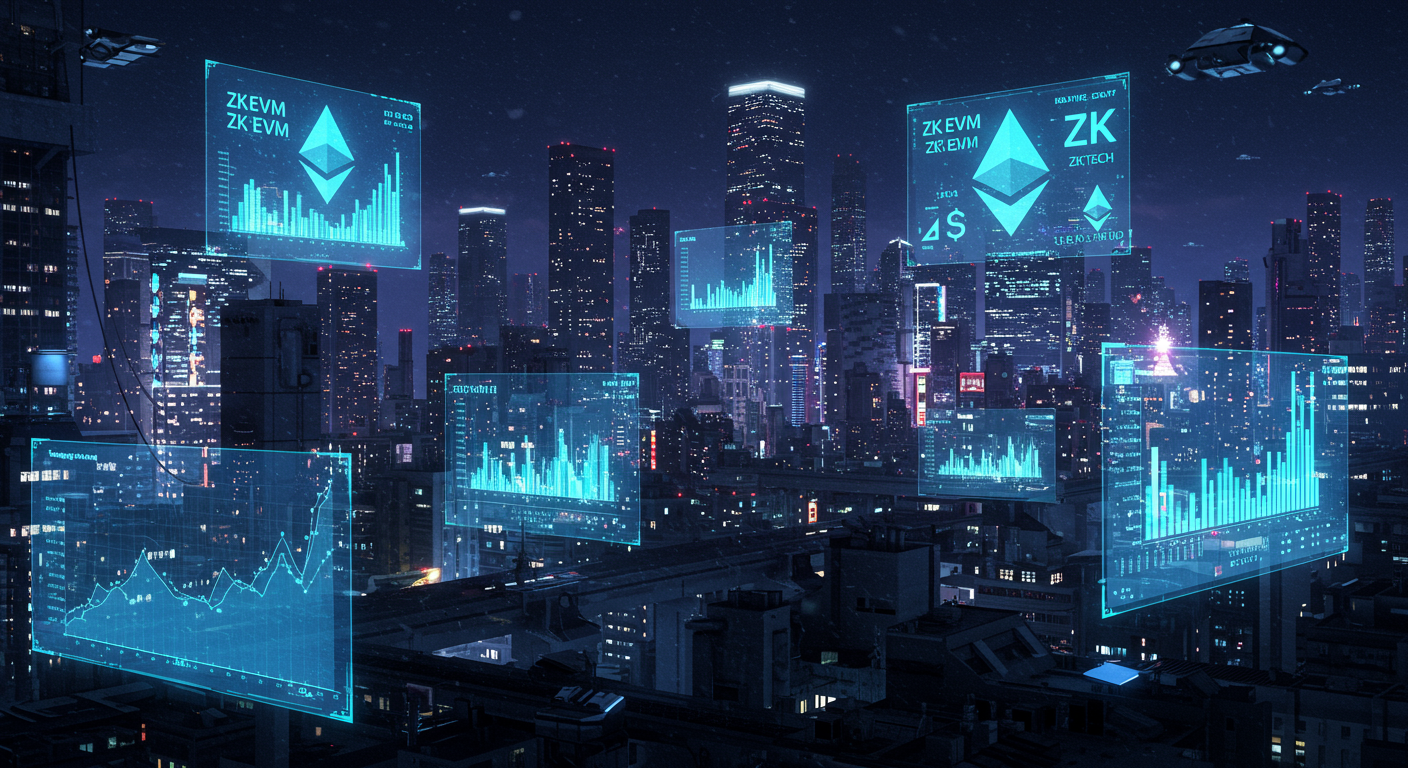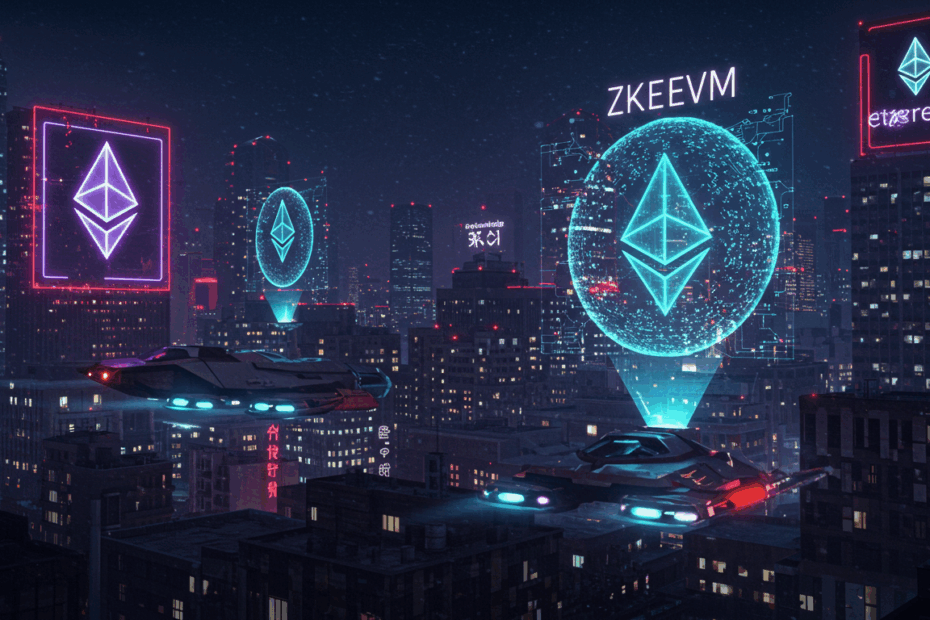Ethereum’s Next Evolution: A Deep Dive into the L1 zkEVM and the Era of Full ZK Adoption
John: There are moments in the evolution of a technology that feel like a quiet tremor before a seismic shift. We’re in one of those moments with Ethereum right now. The recent announcements from the Ethereum Foundation aren’t just another upgrade; they’ve outlined a clear, determined roadmap to go “all in on ZK,” starting with the integration of a zkEVM directly into the main protocol, the Layer 1. This is arguably the most significant architectural change proposed since the move to Proof-of-Stake.
Lila: Okay, John, you’ve definitely got my attention. But for our readers who are maybe just getting their heads around what “Layer 2” means, phrases like “full ZK adoption” and “L1 zkEVM” sound incredibly dense. Why is this specific news causing such a buzz? What does it mean when the headlines say Ethereum is planning a “transformative zkEVM integration”? Is this just for the hardcore crypto-devs, or will the average person using an app on Ethereum actually feel this change?
John: That’s the perfect question, Lila. It cuts right to the heart of it. This change is for everyone, even if they never know the term zkEVM. For years, Ethereum’s core challenge has been the classic blockchain trilemma: trying to balance decentralization, security, and scalability. It has excelled at the first two, but scalability—its ability to handle high volumes of traffic cheaply and quickly—has been its Achilles’ heel. This move is a direct, powerful, and elegant strategy to solve that problem at its very root. It’s like we’ve been trying to widen the roads in a congested city, and now the plan is to replace the roads entirely with a hyperloop system. The goal is a faster, cheaper, and more efficient Ethereum for all.

So, What Exactly Are We Talking About? A Simple Guide to ZK and the zkEVM
Lila: Hyperloop sounds good, but let’s pump the brakes a little. Before we get to the L1 integration, can we break down the core component? What is a “Zero-Knowledge Proof,” or ZKP? The name itself sounds like a paradox.
John: It does, but the concept is surprisingly intuitive. A Zero-Knowledge Proof is a cryptographic method that allows one party (the prover) to prove to another party (the verifier) that they know a piece of information, without revealing the information itself. Think of it like the classic “Where’s Waldo?” puzzle. You could prove to me that you’ve found Waldo in a massive picture in one of two ways. The first way is to point directly at him, revealing his location. That’s a traditional proof.
Lila: Right, you show me the secret.
John: Exactly. But the zero-knowledge way would be for you to take a giant piece of cardboard, cut out a small hole just big enough to show Waldo, place it over the picture, and show me. I can see you’ve found him, but I learn nothing else about the rest of the picture—his location is kept secret from me. You’ve proven your knowledge with “zero” extra information. In the blockchain world, this is revolutionary. It allows us to verify that a complex computation was done correctly without having to re-run the entire computation ourselves.
Lila: Okay, that makes sense. It’s a verification shortcut. So how does that connect to the “EVM” part? I know that stands for the Ethereum Virtual Machine.
John: Precisely. The EVM is the heart of Ethereum. It’s the global computer, or processing environment, where all smart contracts live and all transactions are executed. Every single node in the Ethereum network has to run the EVM to process transactions and verify the state of the blockchain. This is what makes it secure and decentralized, but it’s also what makes it slow and expensive. Everyone has to do all the work.
Lila: So a zkEVM is a Zero-Knowledge version of that machine? A brain for Ethereum that can use that “Where’s Waldo?” trick?
John: You’ve got it. A zkEVM is an environment that is designed to be compatible with the Ethereum Virtual Machine but can execute transactions and then generate a ZK-proof of their validity. It’s been the holy grail for Ethereum scaling researchers for years. It means you can build applications using the same tools and programming languages (like Solidity) that developers already know and love, but run them in a system that can be verified with incredible efficiency using ZK-proofs. This paves the way for what the Ethereum Foundation calls “full zero-knowledge proof adoption.”
The Technical Mechanism: How Does This Magic Actually Work?
John: To understand the new L1 proposal, we first need to look at how this technology is used today in what are called ZK-Rollups. These are Layer 2 scaling solutions—separate blockchains that run on top of Ethereum. They work by bundling or “rolling up” thousands of transactions off the main chain, processing them in their own high-speed environment, and then generating a single, tiny cryptographic proof (specifically, a ZK-SNARK or ZK-STARK) that attests to the validity of that entire batch.
Lila: So that’s the courier analogy I’ve heard. Instead of the main post office—Ethereum—having to read and process 10,000 individual letters, the ZK-Rollup acts like a trusted courier who delivers a single, notarized summary document that just says, “I’ve checked all 10,000 of these letters, and they are all valid.” Ethereum just has to check the notary’s seal, not re-read every letter.
John: A perfect analogy. That “notary’s seal” is the ZK-proof. It’s mathematically guaranteed to be valid, and verifying it is computationally trivial compared to re-executing 10,000 transactions. This is how Layer 2s like Polygon zkEVM, Starknet, and zkSync achieve massive scalability and offer users transaction fees that are a fraction of the cost on Ethereum’s mainnet. They take the computational load off-chain and just use the mainnet for security and final settlement.
Lila: Okay, so if that’s already working so well on Layer 2, what is the point of this new “L1 zkEVM” or “enshrined zkEVM” plan? What does it mean to bring it to the core of the protocol?
John: This is the transformative part. The new plan proposes to integrate a zkEVM *natively* into Ethereum’s Layer 1. Instead of validators having to re-execute all the transactions within a new block to confirm it’s valid, they could simply verify a ZK-proof that comes with the block. This is what the Foundation’s post on “real-time block validation” is all about. It makes the core process of running the Ethereum blockchain itself vastly more efficient.
Lila: So, it would be like upgrading the main post office itself to understand and trust those notarized summaries directly, making its own internal processes faster for everyone? And I’ve seen discussions about different “types” of zkEVMs, from Type 1 to Type 4. Is that important here?
John: Very important. The “type” refers to the level of compatibility with the existing Ethereum EVM. A Type 1 zkEVM is the ideal—it’s perfectly equivalent to the Ethereum mainnet, meaning no changes are needed for existing applications or developer tools. It’s essentially a ZK-powered clone of the EVM. Other types might require small modifications or different compilation steps. The goal of the L1 zkEVM is to be as close to Type 1 as possible to ensure a seamless and secure transition. This focus on equivalence is key for driving developer and user adoption.
Team & Community: The Minds Behind the Movement
John: It’s crucial to understand that this isn’t the work of a single company. The push for a ZK-powered Ethereum is a massive, ecosystem-wide effort that has been years in the making. At the top, you have the Ethereum Foundation, a non-profit organization that supports the development of the core protocol. Researchers and developers there, including co-founder Vitalik Buterin, have been laying the theoretical groundwork for this future for a long time.
Lila: But the Foundation doesn’t build everything themselves, right? I know there are big, venture-backed companies in this space.
John: Correct. The actual implementation and innovation in zkEVM technology have been fiercely driven by several independent teams. We have:
- Matter Labs, the team behind zkSync.
- Polygon, which has multiple ZK solutions, including Polygon zkEVM.
- StarkWare, the creators of the STARK proof system and the Starknet network.
- Scroll, which has focused heavily on achieving EVM equivalence.
- And several other brilliant teams like ConsenSys with its zkEVM.
This has created a dynamic of “co-opetition”—they are all competing to build the best Layer 2 solution, but their research and open-source contributions have collectively advanced the entire field.
Lila: So what happens now that the Ethereum Foundation has announced this plan to build a native L1 zkEVM? Does it step on the toes of these companies who have invested so much in building their own?
John: That’s the billion-dollar question, and we’ll touch on it more in a bit. But the official stance and the general structure of the community is collaborative. The Foundation’s plan is to incorporate the best ideas and even code from these existing projects. They are actively offering grants and fostering a multi-client ecosystem. The idea is that a rising tide lifts all boats; a more scalable Ethereum base layer benefits everyone. However, it undoubtedly changes the strategic landscape for these Layer 2 teams.

Use-Cases & Future Outlook: Why This is a Game-Changer
Lila: Okay, let’s get to the fun part. Assuming this all works, what does this unlock? What can we do with a hyper-scalable Ethereum that we can’t do today because of high gas fees and slow speeds?
John: The possibilities are vast and genuinely exciting. The current limitations have relegated many potential applications to the drawing board. With near-instant, sub-cent transactions, we could see the emergence of:
- Truly Scalable Decentralized Finance (DeFi): Imagine complex trading strategies, lending, and borrowing, all happening on-chain with the speed of a centralized exchange but the security of Ethereum.
- On-Chain Gaming and Metaverses: Games where every item is an NFT (Non-Fungible Token) and every action is an on-chain transaction become viable. No more paying $50 in gas to mint a new sword. The Metaverse could actually be built on-chain.
- Decentralized Social Media: Platforms where users truly own their data and control their identity, with micro-transactions for tipping or content promotion becoming seamless.
- Enterprise Adoption: Corporations could use the public Ethereum mainnet for supply chain management, credential verification, and other data-intensive tasks that are currently prohibitively expensive.
Lila: So it’s about moving beyond just financial speculation and enabling real-world, high-frequency applications? It sounds like it’s graduating from a niche technology to a potential backbone for a new internet.
John: That is precisely the vision. The Ethereum Foundation’s plan for “full ZK adoption” goes even further. They envision using ZK-proofs at all levels of the protocol stack—from verifying transactions in a zkEVM to even aggregating signatures in the consensus layer. It’s a holistic strategy to make the entire network exponentially more powerful. If successful, as some have noted, Ethereum will become the largest live deployment of zero-knowledge technology in history, fundamentally reshaping what’s possible with blockchain infrastructure.
Competitor Comparison: L1 zkEVM vs. L2 ZK-Rollups
Lila: Let’s circle back to that tricky question. The SERPs are full of headlines wondering what this means for the existing Layer 2 projects. If Ethereum integrates native zkEVM support, does that make ZK-Rollups redundant? Why would I use a Layer 2 if Layer 1 becomes cheap and fast?
John: It’s a critical point of discussion, and it signals a maturation of the ecosystem. The short answer is no, it doesn’t make L2s obsolete, but it fundamentally changes their value proposition. Think of the relationship between a country’s federal highway system (Layer 1) and a city’s local roads and specialized transport systems (Layer 2). If you upgrade the federal highway from a two-lane road to a 20-lane superhighway, you don’t tear down the city’s roads. In fact, the superhighway makes the city more accessible and valuable.
Lila: So the L1 zkEVM is that superhighway upgrade. How do the L2s adapt?
John: They adapt by specializing. Their role shifts. With a highly scalable base layer, L2s no longer have to compete primarily on just being “cheaper than L1.” They can differentiate in other ways:
- Extreme Scalability: They can take the new, higher throughput of L1 and multiply it further, creating environments for applications that need millions of transactions per second.
- Customizable Environments: An L2 could be optimized specifically for gaming, with a unique execution environment that a general-purpose L1 couldn’t support. Another could be built for privacy, using ZK-proofs to create a fully confidential transaction layer.
- App-Chains: We’ll likely see more applications launching their own dedicated L2, or “app-chain,” to have complete control over their environment and economics.
However, the pressure is on. Native zkEVM support commoditizes their core scaling technology. L2s that don’t innovate beyond basic scaling will find it very hard to compete.
Risks & Cautions: What Are the Potential Pitfalls?
Lila: This all sounds incredibly ambitious and complex. It can’t be all sunshine and roses. What are the major risks we should be watching out for?
John: You’re right to be cautious. The risks are significant, which is why the rollout is planned to be so gradual. The primary concerns are:
- Technological Complexity: ZK cryptography is at the absolute cutting edge of mathematics and computer science. A subtle bug in the proving system’s code could be catastrophic, potentially allowing for the creation of invalid proofs and the minting of assets out of thin air. Security audits for this tech are incredibly difficult and expensive.
- Prover Centralization: Generating these complex ZK-proofs is computationally intensive. It requires powerful and expensive hardware. There’s a real risk that only a handful of large, well-funded entities will be able to act as “provers,” leading to a new form of centralization and potential censorship. Decentralizing the proving process is a major unsolved research problem.
- Liveness and Security Trade-offs: In the initial stages, the system will rely on a “security council” or fallback mechanisms in case the ZK-proving system fails. This introduces a trusted element that is counter to the core ethos of decentralization, even if it’s a temporary measure.
Lila: So, we’re trading some of the battle-tested, albeit slow, security model for a more efficient but potentially more fragile one, at least in the beginning?
John: That’s a fair assessment. The roadmap is designed to mitigate this. It will start as an optional feature, allowing the network to build trust in the ZK clients over time. The Ethereum Foundation has announced expanded bug bounties and formal verification grants to attract as many expert eyes as possible to scrutinize the code before it handles significant value.

Expert Opinions and The Latest Roadmap
John: If you read between the lines of the official announcements, you can see a clear narrative. Vitalik Buterin has been writing about a “Rollup-centric future” for years, and this is the ultimate expression of that vision. The recent Ethereum Foundation blog post, “Shipping an L1 zkEVM,” marks the transition from theory to a concrete engineering plan. They explicitly state, “Ethereum is going all in on ZK.” This isn’t a side project; it’s the main quest.
Lila: And what is the concrete plan? What does the roadmap look like over the next year or two?
John: The plan is methodical. The first major phase, targeted within a year, is to introduce optional ZK client support for validators. This means a validator—one of the entities that secures the network—can choose to use a new type of client software that verifies blocks using ZK-proofs. This enhances efficiency for individual validators, especially those running on consumer-grade hardware, which is a big win for decentralization.
Lila: So it’s an opt-in system at first? A validator can choose the old “re-execute everything” method or the new “verify the proof” method?
John: Precisely. This allows the network to test and build confidence in the ZK-proofs in a live environment without forcing the entire network to rely on them from day one. As the post states, “Adoption will be driven by formal verification grants, expanded bug bounties, and dedicated security audits.” Once a majority of validators are confidently running ZK clients, Ethereum can move to the next phase: making proof verification a required part of the protocol, fully realizing the vision of real-time block validation for everyone.
Frequently Asked Questions (FAQ)
Lila: Let’s finish with a quick-fire round to summarize the key takeaways for our readers.
John: An excellent idea. Fire away.
Lila: First up: Will the L1 zkEVM upgrade directly lower my gas fees on Ethereum?
John: Yes, that is one of the primary long-term goals. By making the core validation process of the blockchain more efficient, it reduces the computational burden on every node in the network. This increase in capacity and efficiency should lead to a significant reduction in transaction fees on the Layer 1 mainnet and also make Layer 2s even cheaper.
Lila: Next: What is the key difference between a ZK-Rollup and the proposed L1 zkEVM?
John: A ZK-Rollup is a separate, Layer 2 blockchain that executes transactions and then posts a proof back to the Layer 1. Think of it as an attachment to Ethereum. The L1 zkEVM proposal is about integrating this proof-verification capability *directly into the engine* of Ethereum’s Layer 1, making the main chain itself natively fluent in the language of ZK-proofs.
Lila: Is this plan a replacement for Ethereum’s original “sharding” roadmap?
John: In many ways, yes. The original idea for sharding was to split the blockchain into many parallel chains to process transactions. This proved to be incredibly complex to implement securely. The current rollup-centric roadmap, supercharged by an enshrined L1 zkEVM, is now seen as a more direct and potentially more powerful way to achieve massive scalability.
Lila: Does this upgrade automatically make Ethereum a private blockchain?
John: Not by default. The L1 zkEVM focuses on using ZK-proofs for scaling, not privacy. Transactions on the mainnet will still be public. However, by making the underlying technology for ZK-proofs a native part of the protocol, it becomes far easier and more efficient for developers to build powerful privacy applications and Layer 2s (like Tornado Cash or Aztec) on top of Ethereum.
Lila: And finally, the big one: When can I, as a regular user, expect to feel the effects of this?
John: You are likely already feeling the benefits if you use any Layer 2 ZK-Rollups. The direct L1 integration will be a gradual process. The first phase, with optional client support for validators, is expected within a year. Noticeable fee reductions on Layer 1 due to this specific upgrade might take longer, perhaps in the 2-4 year timeframe, as the technology matures and adoption among validators reaches a critical mass. This is a marathon, not a sprint, but the race has officially begun.
Related Links and Final Thoughts
John: For those who want to dive even deeper, the official Ethereum Foundation blog is the primary source. The recent posts on “Realtime Proving” are a must-read for the technical details. Additionally, following the blogs of the major L2 teams provides great insight into the state of the art.
Lila: It’s an incredibly exciting time. It feels like the training wheels are coming off, and Ethereum is preparing for a future where it can truly operate at a global scale. The transition to full ZK adoption seems to be the key that will unlock that potential.
John: I agree completely. It’s a complex, challenging road ahead, but the destination—a decentralized, secure, and scalable world computer—is a goal worth striving for. The foundation for the next generation of the internet is being laid, block by ZK-proven block.
Disclaimer: This article is for informational purposes only and does not constitute investment advice. The cryptocurrency market is highly volatile. Please do your own research (DYOR) before making any financial decisions.
